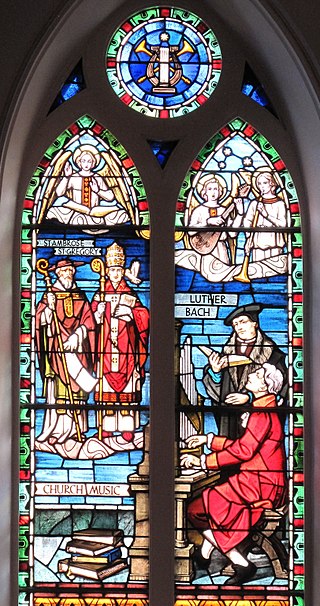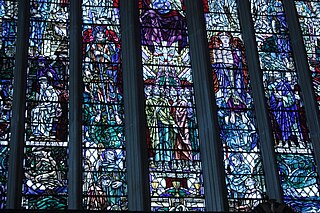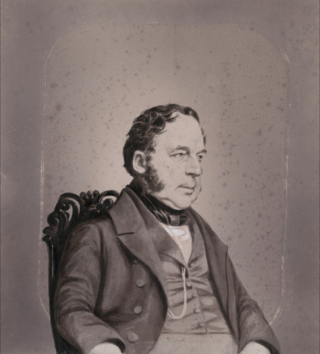
Thomas Denny (born 1956) is a contemporary British painter and stained glass artist.

Thomas Denny (born 1956) is a contemporary British painter and stained glass artist.
Denny was born in London, son of Sir Anthony Denny, 8th Baronet of Tralee Castle, and Catherine née Beverley. [1] He was educated at King Alfred's School, Hampstead, and trained at the Edinburgh College of Art and now lives and works in Dorset. He has exhibited extensively and has had numerous commissions both as a painter and a skilled practitioner of stained glass.
His windows are noted for the distinctive way in which light and colour move across the surface. He achieves this effect by acid etching and silver staining each small piece of glass. [2]
He has been responsible for some 60 stained glass commissions for churches and cathedrals, including the Traherne windows at Hereford Cathedral (2007), the Transfiguration window at Durham Cathedral (2010), and the Wisdom window at St Catharine's College, Cambridge (2012). In 2016 two windows inspired by the life of Richard III were installed in Leicester Cathedral. The windows, which cost £75,000, are sited near the king's tomb in the cathedral. [3]

York Minster, formally the Cathedral and Metropolitical Church of Saint Peter in York, is an Anglican cathedral in the city of York, North Yorkshire, England. The minster is the seat of the archbishop of York, the second-highest office of the Church of England, and is the mother church for the diocese of York and the province of York. It is administered by its dean and chapter. The minster is a Grade I listed building and a scheduled monument.

The Cathedral Church of Saint Martin, Leicester, commonly known as Leicester Cathedral, is a Church of England cathedral in Leicester, England and the seat of the Bishop of Leicester. The church was elevated to a collegiate church in 1922 and made a cathedral in 1927 following the establishment of a new Diocese of Leicester in 1926.

John Egerton Christmas Piper CH was an English painter, printmaker and designer of stained-glass windows and both opera and theatre sets. His work often focused on the British landscape, especially churches and monuments, and included tapestry designs, book jackets, screen prints, photography, fabrics and ceramics. He was educated at Epsom College and trained at the Richmond School of Art followed by the Royal College of Art in London. He turned from abstraction early in his career, concentrating on a more naturalistic but distinctive approach, but often worked in several different styles throughout his career.

John La Farge was an American artist whose career spanned illustration, murals, interior design, painting, and popular books on his Asian travels and other art-related topics. La Farge made stained glass windows, mainly for churches on the American east coast, beginning with a large commission for Henry Hobson Richardson's Trinity Church in Boston in 1878, and continuing for thirty years. La Farge designed stained glass as an artist, as a specialist in color, and as a technical innovator, holding a patent granted in 1880 for superimposing panes of glass. That patent would be key in his dispute with contemporary and rival Louis Comfort Tiffany.

Franz Mayer of Munich is a German stained glass design and manufacturing company, based in Munich, Germany and a major exponent of the Munich style of stained glass, that has been active throughout most of the world for over 170 years. The firm was popular during the late nineteenth and early twentieth century, and was the principal provider of stained glass to the large Roman Catholic churches that were constructed throughout the world during that period. Franz Mayer of Munich were stained glass artists to the Holy See and consequently were popular with Roman Catholic clients. The family business is nowadays managed by the fifth generation and works in conjunction with renowned artists around the world.

Charles Eamer Kempe was a British Victorian era designer and manufacturer of stained glass. His studios produced over 4,000 windows and also designs for altars and altar frontals, furniture and furnishings, lychgates and memorials that helped to define a later nineteenth-century Anglican style. The list of English cathedrals containing examples of his work includes: Chester, Gloucester, Hereford, Lichfield, Wells, Winchester and York. Kempe's networks of patrons and influence stretched from the Royal Family and the Church of England hierarchy to the literary and artistic beau monde.

Douglas Strachan is considered the most significant Scottish designer of stained glass windows in the 20th century. He is best known for his windows at the Peace Palace in The Hague, Netherlands, at Edinburgh's Scottish National War Memorial and in cathedrals and churches throughout the United Kingdom. He is also known for his paintings, murals, and illustrations.

Thomas Willement was an English stained glass artist and writer, called "the father of Victorian stained glass", active from 1811 to 1865.

William Warrington, (1796–1869), was an English maker of stained glass windows. His firm, operating from 1832 to 1875, was one of the earliest of the English Medieval revival and served clients such as Norwich and Peterborough Cathedrals. Warrington was a historian of medieval glass and published an illustrated book The History of Stained Glass.

Clayton and Bell was one of the most prolific and proficient British workshops of stained-glass windows during the latter half of the 19th century and early 20th century. The partners were John Richard Clayton (1827–1913) and Alfred Bell (1832–1895). The company was founded in 1855 and continued until 1993. Their windows are found throughout the United Kingdom, in the United States, Canada, Australia and New Zealand.
William Peckitt was an English glass-painter and stained glass maker. He was based in York throughout his working life, was one of the leading Georgian glass craftsmen in England and helped "keep the art of glass painting alive during the eighteenth century". In fact, "it was William Peckitt who did most of the stained glass and painted glass work that survives from the second half of the eighteenth century".
Nicholas Patrick Reyntiens OBE was a British stained-glass artist, described as "the leading practitioner of stained glass in this country."

Karl Bergemann Parsons was a British stained glass artist associated with the Arts and Crafts movement.

Lawrence Stanley Lee was a British stained glass artist whose work spanned the latter half of the 20th century. He was best known for leading the project to create ten windows for the nave of the new Coventry Cathedral. His other work includes windows at Guildford and Southwark Cathedrals as well as a great number of works elsewhere in the UK, and some in Canada, Australia and New Zealand.
Brian Thomas (1912–1989) was a British artist best known for his decorative work in church buildings, particularly murals and stained glass.

Henry Haig was an English abstract artist, painter and sculptor but notable predominantly for his stained glass work.
Patrick Pollen was a British stained-glass artist who spent most of his life working in Ireland.

Michael Healy was an Irish stained glass artist, one of a small number which included Wilhelmina Geddes, Evie Hone, and Harry Clarke, who achieved international recognition for their work in this medium in the first half of the 20th century. He also achieved some distinction as an illustrator and cartoonist early on in his artistic career, and as an ongoing recorder of Dublin street characters going about their daily business. Healy also occasionally painted in oil, both portraits and landscapes, exhibiting a small number of the latter during his lifetime.
John Prudde was the leading English glass painter of the mid 15th century. He held the office of King's Glazier from 1440 until his death. He worked on a variety of high-profile projects, both public and private, but the only work of his now known to survive is in the Beauchamp Chapel of St Mary's Church, Warwick. This has been described as having "a glittering effect unmatched within the British Isles", the result of his mastery of the technically demanding art of inserting brightly-coloured "jewels" of painted glass into the middle of panes of glass.